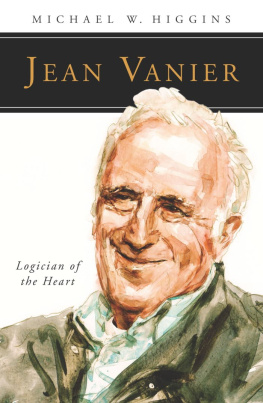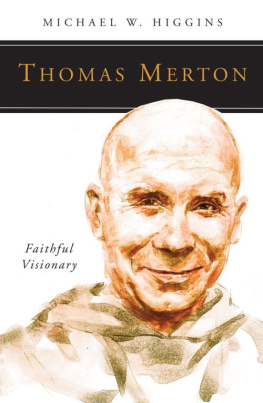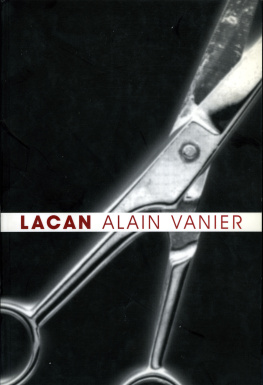Cover design by Stefan Killen Design. Cover illustration by Philip Bannister.
2016 by Order of Saint Benedict, Collegeville, Minnesota. All rights reserved. No part of this book may be reproduced in any form, by print, microfilm, microfiche, mechanical recording, photocopying, translation, or by any other means, known or yet unknown, for any purpose except brief quotations in reviews, without the previous written permission of Liturgical Press, Saint Johns Abbey, PO Box 7500, Collegeville, Minnesota 56321-7500. Printed in the United States of America.
Library of Congress Control Number: 2015945305
ISBN 978-0-8146-3710-4 978-0-8146-3735-7 (ebook)
To Sue Mosteller of the Congregation of St. Joseph
a friend and associate of Jean Vaniers of several decades standing,
a sublime witness to the spirit and philosophy of LArche,
and a personal friend and spiritual mentor to me.
Acknowledgments
It has been a privilege and a grace to write this book. I have known Jean Vanier for many yearswe cooperated on a major event at St. Jeromes University and we have exchanged letters around our respective publications. In addition, I have written on Vanier and his work for The Literary Review of Canada and Commonweal .
Interviews for this book and related research are greatly dependent on the technical skill and searching intelligence of producer and editor Kevin Burns. The extensive quotations that appear throughout the text and lack citations are the result of these oral interviews.
Especially important as a resource was the fifth chapter of Power and Peril: The Catholic Church at the Crossroads, by Michael W. Higgins and Douglas R. Letson (Toronto: HarperCollins, 2002), and the fourth chapter of Stalking the Holy: The Pursuit of Saint-Making , by Michael W. Higgins (Toronto: Anansi, 2006).
I am indebted both to the creative forbearance of my partner and wife, Krystyna, whose own pressing publication deadlines never deflected attention from my own work and whose generosity of spirit and magnanimity is boundless, and to the patient endurance of my administrative assistant, Ami, who contributed immensely to providing the time and space for the research and writing.
Various figures associated with LArche and longtime friends of Vaniersincluding Sue Mosteller, Nathan Ball, and Carolyn Whitney-Brownwere especially helpful. Don Morrison provided funding for a trip to Trosly and shared, with Eleanor Clitheroe-Bell and myself, in a several-hour discussion with Jean on his home turf. This is all grist for the writers mill. I wish also to thank my daughter, Sarah, an MFA graduate student at the University of British Columbia, who read the manuscript with her customary care and prepared the index.
And finally, President John Petillo of Sacred Heart University has been an encouraging resource throughout this and other writing projects.
Introduction
Jean Vanier is one of the most honored men on the planet. Not that he cares. Honors are important, for sure, but they are not for him. The honors he has received, he has received for those with whom he lives, those who never receive honors and often never receive any recognition at all. They are the marginalized, the forgotten, the detritus of society. They are not the company of the honored.
But they are his company: preferred, embraced, lovedunconditionally.
In an interview in The United Church Observer in November 2013, Vanier spoke frankly about why we need people with disabilities: there is a mystery with these people with disabilities; they are the very presence of Jesus. For sure we can see their fragility, their weakness, and their pain, but at the same time we recognize their special place with God. In fact as wesometimes reluctantly, sometimes fearfullyenter ever so tentatively into relationship with them, we discover that they change us.
Vanier recounted for the interviewer his encounter with Andrew, a man with whom he spent a year living in community. One day Andrew went to see a cardiologist, and when he returned home Vanier asked him what happened. Andrew said that the doctor had looked into his heart. Vanier then asked what the doctor saw in his heart, and Andrew replied: He saw Jesus, of course.
Vanier then asked what Jesus does in his heart, and his theologically astute interlocutor said that Il se reposeJesus takes his rest/quietness there.
This is what the mystics say. It is what the gospels say: Jesus lives in our hearts. In fact, Vanier mused, the great spiritual writer Etty Hillesum, who was to perish in Auschwitz, made much the same point when she argued that though there was not much God can do for us in the encompassing darkness of the Reich, we can give God our hearts and be Gods refuge in the world, a world that rejects the Divine.
Providing a place for God to rest is part of the vocation, the ministry, and the witness of people who are disabled. There is something very particular in their kindness, in their affection. For a year Vanier lived at La Forestire with the most severely disabled members of the LArche home in Trosly-Breuil, the foundation or motherhouse of the worldwide network of community homes that live under the sign of the Ark. At La Forestire he would give them baths, and in so doing he discovered that it was a great and liberating mystery to touch the bodies of those who couldnt communicate verbally. In fact it was unnecessary to do so; their very bodies proclaimed love me. Such a communication arose naturally from the very depths of who they arethey are their bodies, broken, ruptured, fragile, incomplete. But theirs are wrapped in love.
Their bodies are tender, and there is something deeply significant in that. Vanier remembers that at one point he asked their community psychiatrist what it means to be a pure human person, and he responded unhesitatingly: tenderness.
It is tenderness that reveals our ability to speak with great respect of others and in a way that allows us to give security to them without actually possessing them. The tenderness of the disabled heals us, breaks us free from what Thomas Merton, quoting Albert Camus, calls the plague of cerebration. For Vanier the intellectualizing of the faith by the church obscures the greater truth, a truth that is enfleshed and not conceptualized, the truth that allows the other, Jesus, Andrew, the unnamed and ignored, to rest in our hearts.
This is the essence of the teachings of Jesus. It is the principle, ethos, substratum, very life, and meaning of LArche itself: Jesus lives in our hearts as we live in his.
The LArche message is the text of the person of Jesus, his radicality. When we hold a meal it is not the familiar we should invitethe friends, the wealthy, and the affluent. Rather, it should be those who are poor, lame, blind, and disabled. This is not the doctrine of Nietzsche.
The tribe can crush the spirit; we need to break out of our secure orbit; we need to risk.
The people who are disabled are our reward.
And they remind us of the deeper truths, the truths that sustain us as a culture, humanize and ennoble us. This is never more imperativethis awareness, this memorythan now, when we are besotted with the allure of security, wealth, and access to chemicals and treatments that can prolong our escape from mortality. Those who are intellectually and physically challenged have no time for illusions; they force us to confront the reality , not the false dreamscape of humanness. They are the true sentinels of our larger hope.
In a time when the throwaway culture so vigorously condemned by Pope Francis still holds sway, and in a time when economic disparity has never been so wide, dangerously wide, the witness and teachings of Jean Vanier have never been so necessary.












